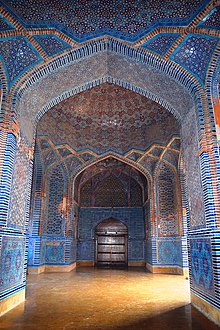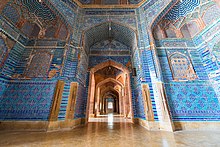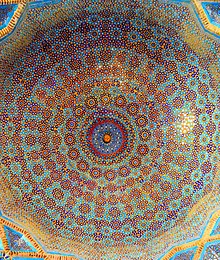SHAH JAHAN MOSQUE

ThattaFor the Ahmadiyya Mosque in England, see Shah Jahan Mosque, Woking.
Shah Jahan Mosque
شاہ جہاں مسجد

The mosque is considered to have the most elaborate display of tile work in South Asia.[1][2]
Religion
Affiliation
Islam
District
Thatta
Province
Sindh
Year consecrated
1647
Location
Location
Thatta
Pakistan
Architecture
Style
Mughal, Safavid, Timurid
Completed
1659
Specifications
Dome(s)
93
Materials
Red bricks and tiles
The Shah Jahan Mosque (Urdu: شاہ جہاں مسجد), also known as the Jamia Masjid of Thatta (Urdu: جامع مسجد ٹھٹہ), is a 17th-century building that serves as the central mosque for the city of Thatta, in the Pakistani province of Sindh. The mosque is considered to have the most elaborate display of tile work in South Asia,[1][2] and is also notable for its geometric brick work - a decorative element that is unusual for Mughal-period mosques.[3] It was built during the reign of Mughal emperor Shah Jahan, who bestowed it to the city as a token of gratitude,[1] and is heavily influenced by Central Asian architecture - a reflection of Shah Jahan's campaigns near Samarkand shortly before the mosque was designed.[1]
Background

The mosque's tile work exhibits Timurid influences introduced during Shah Jahan's campaigns in Central Asia.
Shah Jahan sought refuge in Thatta from his father Emperor Jahangir, after he had rebelled against his father.[4] Shah Jahan was impressed by the hospitality he received by the Sindhi people, and ordered construction of the mosque as a token of gratitude.[1][5] Construction of the mosque may have also been partially motivate by a desire to help alleviate the effects of a devastating storm that impacted the region in 1637,[3] and which had nearly destroyed Thatta.[1]
Shah Jahan's campaigns in Central Asia during this era influenced the mosque's architectural style, as Timurid influences were introduced into the Mughal Empire as his armies pressed towards Samarkand, in modern-day Uzbekistan.[1] Despite the fact that the Emperor was not in the region during its construction, and so was unlikely directly involved in its construction, its profuse tile-work and intricate brick work indicate that it was funded by the Mughal's imperial coffers.[3]
History

The entry way to the main prayer hall is from the central courtyard.
Pesian inscriptions at the mosque indicated that it was built between 1644 and 1647,[3] during the reign of Mughal Emperor Shah Jahan. An eastern addition was completed in 1659,[6] during the reign of Emperor Aurangzeb.
The mosque's mihrab had initially been incorrectly aligned with Mecca. The Sufi mystic, Makhdum Nooh, who is buried in the nearby city of Hala is said to have been approached by the mosque's planners in order to correct its alignment. Popular tradition maintains that Makhdum Nooh then corrected the error overnight by the power of his prayer, thereby ensuring his status as a saint.[7] Historical records show that the mosque's mihrab had actually been rebuilt a century after the mosque's construction.[7]
Architecture
The Shah Jahan Mosque's architectural style is overtly influenced by Turkic and Persian styles.[8] The mosque is characterized by extensive brickwork and the use of blue tiles, both of which were directly influenced by Timurid architectural styles from Central Asia[3][1] − from where the previous rulers of Sindh, the Tarkhans, had hailed before the region was annexed by the Mughals in 1592.[3]
Decorative elements
Tile work

The mosque's main dome has tiles arranged in a stellate pattern to represent the night sky.[3]
The profuse use of tiles is considered to be the most elaborate display of tile work in the Indian Subcontinent.[1][2] Unlike the Wazir Khan Mosque in Lahore, another Shah Jahan era mosque, the mosque in Thatta does not employ the use of fresco.
The mosque's tiles represent a direct influence of the Timurid style.[1] The mosque employs Cobalt blue, turqoise, manganese violet, and white tiles.
The mosque's dome is embellished with exquisite blue and white tile-work arranged in stellated patterns to represent the heavens.[3] Its walls feature calligraphic tile work, signed by Abdul Ghafur and Abdul Sheikh.[9]
The tiles' location and arrangement displays Persian Safavid influence,[1] and features several colours on a single tile,[3] unlike tile work at Lahore which featured a single colour on each tile.[3] The use of multicolour tiles and floral patterns reflects Persian Kashani influences.[2]
Brick work

The mosque showcases brickwork in geometric patterns.
The mosque features extensive brickwork laid in geometric patterns, which is a decorative element unusual for Mughal era mosques,[3] and is an element of Timurid architecture adopted for use in the mosque.[3] The mosque's brickwork was also influenced by Sindhi vernacular styles, which in turn was influenced by Persian architecture.[3] Brick work is most notable in the arcades surrounding the central courtyard, while concentric rings of brick are used to embellish the underside of peripheral domes.
Layout

Brickwork along corridors
The layout of the mosque may have been influenced by the conservative Timurid-style Humayun Mosque in Kachhpura, near the city of Agra,[3] in modern-day India. The main entryway into the mosque complex is through a Persian-style Charbagh, or quadrangle garden.
The main prayer hall is set to the west of its central courtyard, which features iwans, or portals, in each of its four cardinal directions. The courtyard is rectangular in shape, and measures 169 feet by 97 feet. It is surrounded by aisled galleries, which are lined with 33 arches.
The mosque's mihrab features pierced screens - an element that is commonly employed on Mughal funerary monuments, but unusual in Mughal mosques.[3] The mosque features excellent acoustics; a person speaking on one end of the dome can be heard from the other end when the speech exceeds 100 decibels.[10] Prayers in the main prayer hall can be heard throughout the entire building.[2]
The mosque is unusual for its lack of minarets. It has a total of 93 domes, the most of any structure in Pakistan.[10]#fastitlinks.com

No comments:
Post a Comment